In honor of International Left Handers Day on August 13th, it is my great pleasure to write an article celebrating the joys of fountain pens for left handers. Happy International Left Handers Day! If you are a left hander who is new to fountain pens and are nervous about trying them, I want to say to you right away: don't be afraid or feel like fountain pens are off-limits for you. Fountain pens are for everyone! Yes, you may have a few challenges when writing, but I have recommendations just for lefties. If you're right handed, don't stop reading: you, too, may learn about products you'd love, and it's always healthy to think about things from a new perspective.
Laura's Top 10 Lefty Recommendations
In this article, I'll go into depth about using fountain pens left-handed, and discuss in detail the products that I especially recommend, but here's a quick list for easy reference.
Left Hander Insights
I'm not a lefty, but I have two left-handed older brothers, and have always thought being left-handed was cool. Whenever I notice someone writing with their left hand, it captures my attention and I automatically find them more interesting. I call myself a "lefty wannabe." Thanks to my childhood desire to be like my brothers and do things left-handed, I brush my teeth with my left hand (using my right hand feels incredibly awkward!), and wear my watch on my right wrist. I also often hold my fork with my left hand. However, I do not write with my left, so I had to do some research for this article, and talking with my left-handed coworker Pierce was eye opening. Pierce is new at Pen Boutique, and he's very eager for the opportunity to explore fountain pens and inks more deeply. Being left-handed has made him get creative and try some alternative methods and products that are particularly suited to the way he holds his pen. We have a lot of left-handed customers, and I think it's great that we now have someone on the Pen Boutique team who understands the unique challenges that left-handers can face when using fountain pens.
When talking with Pierce about his experience as a left-hander going down the "rabbit hole" into the world of fountain pens, my big takeaway was that it's a myth that left-handers, as a whole, can only use certain pens. He shared that, when he was first learning about fountain pens several years ago, well-meaning people had recommended starter pens like the Pelikano Junior and Pelikan Twist to him because the Pelikano Junior offers a left-handed nib option and the Twist is marketed as "suitable for both right and left handed writers." They aren't bad pens, but Pierce is in his early twenties and wanted a cool pen to express himself with. Being steered toward kid-friendly pens, with the implied message that he could only use a few beginner pens suitable for left-handers, was disconcerting rather than empowering. In his words, "It felt yucky." I get it, and I'm thankful for his honesty.
Pierce's first fountain pen ended up being a Lamy Safari, which is definitely an excellent introduction to fountain pens for someone of any age. He loved getting the Lamy left hand nib on it, because it made him feel special, but he later realized that, although the LH nib does feel great when he writes, he doesn't need it, and he really wants to make sure fellow left-handers don't avoid other pens, thinking that they won't work. It took him a while to realize this, but, when he did, it was very exciting and he felt like his world had expanded exponentially. He has now experimented with many different pens and nibs, and, while some work better than others for his particular handwriting angle, style, and pressure, that is true for any fountain pen user.
Pierce's favorite recent acquisition is his Nahvalur Nautilus, which is a dry writer, so he is less likely to smear his ink when using it. He also loves the sleek looks, inspired by a submarine. Pierce and I experimented with some different inks for this article, and he especially liked the Pelikan 4001 series, which is what I usually recommend to writers asking for dry writing or quick-drying inks. His favorite was Pelikan 4001 Blue-Black, so I gave him a sample from my bottle. (Pelikan Blue-Black has a cool story, and you can read all about it in my article, Blue-Black: the Best of Both Worlds.) He used it to fill his Nautilus, and says, "They feel like home together." Although both are on the dry side, the combination just works, and isn't overly dry.

[Pictured: Pierce writing with his Nahvalur Nautilus while trying Pilot nibs with me after hours at the Washington DC Fountain Pen Supershow. Pierce was blown away by the nibs I chose for him, and I'll get more into that later!]
Pierce also loves Pilot and Sailor pens because their nibs can write very fine, which he says helps with keeping his hand away from his lettering. He was particularly excited to learn that Sailor makes a special Lefty 1911L, which is now near the top of his wishlist.
Overwriters, Underwriters, and Sidewriters
The reason Lamy and Sailor make special left handed nibs is that being an overwriter or sidewriter can be particularly challenging with fountain pens. Overwriters hook their left hand above the writing line (often with the hand curled around the pen), and tend to hold their pens at steep angles, which can lead to ink flow issues for a fountain pen, since many nibs are ground in such a way that they write finer and drier when held at a higher angle. Although the overwriter position is more comfortable for many left handers, it also makes it more likely for you to smear your ink, as your hand can rub across your words as it moves from left to right across the page. Workarounds include holding your pen further back, learning to use a lower angle, rotating the paper at least 45 degrees, and using faster drying inks. These can really help make writing with a fountain pen easier and more enjoyable, and can be game-changers!
 [Pictured: fountain pen collector, seller, and Pen World magazine contributing editor Barry Gabay at the Washington DC Fountain Pen Supershow this past weekend, writing with his Pelikan M800. Barry is an overwriter who is very experienced at writing with many different kinds of fountain pens!]
[Pictured: fountain pen collector, seller, and Pen World magazine contributing editor Barry Gabay at the Washington DC Fountain Pen Supershow this past weekend, writing with his Pelikan M800. Barry is an overwriter who is very experienced at writing with many different kinds of fountain pens!]
Sidewriters, who write with a straight wrist and move their hand directly across the words they are writing, are especially likely to smudge their ink. Pierce is a sidewriter, and he told me, "Growing up, I really was the smudger kind of person, so my hand would be completely black" with pencil lead.

Sidewriters are also likely to hold the pen at a high angle, and some, like Pierce, tilt their paper and turn the pen so that it's upside down to help avoid smearing and to get a smoother feeling movement with their nibs. Instead of using a tripod style grip, Pierce wraps his index finger and thumb around the pen. Some of my right-handed teammates use this same grip! It looks unconventional, but it does work for them, and they have nice handwriting.
What is most important when writing with a fountain pen is that the nib is positioned at an angle that allows the tipping material at its end to maintain good contact with the paper, and that this position is maintained as you continue to write with the pen. This means both that the pen cannot be rotated too much to either side and that your angle to the page shouldn't be too high or too low. For most fountain pens, the angle between pen and paper for best ink flow is usually around 40°-55°, and the nib will perform best when the flat part faces up. Although I'm not a lefty, I find that certain nibs are incompatible with the way I hold my pen, too, because I tend to write with my pen slightly twisted outward.
The reason your nib's position is so important is that a fountain pen's liquid ink is delivered through the nib and feed to the paper by a combination of gravity and capillary action. When the tip of the pen comes in contact with the paper, a capillary force helps draw the ink out through the narrow slit between the tines and onto the paper. Some nibs are more forgiving about this than others, but you need to stay within the nib's "sweet spot," or the tip will lose contact with the paper, capillary action will be interrupted, ink will stop flowing, and you will see breaks in your pen's lines (this is called "skipping"), or the pen may stop writing entirely.
Overwriters and sidewriters are more likely to struggle with nibs that have strict sweet spots, but please don't get frustrated and give up if you need to practice a little before you get the hang of it, or if certain nibs just aren't compatible with your hold! I own about 50 fountain pens, and all my pens write well for me, but there have been times when I decided a pen or nib just wasn't for me because its sweet spot was too precise for my tendency to rotate slightly outward.
Both overwriters and sidewriters can especially benefit from nibs that allow for a wider range of angles, including the Lamy LH nib, Lamy Cursive nib (which has been discontinued, but I highly recommend it, if you are able to get your hands on one), Sailor Lefty pens, Sailor Tuzu, and Pilot's Waverly and Signature nibs, found on the Custom Heritage 912, Custom 743, and Custom 823 models. I personally love Pilot's Waverly and Signature nibs, too, even though I'm right-handed!
Ronan, the teenage son of Pen Boutique owners Leena and Raj, is left-handed and used to be an overwriter, but he switched to an underwriter style for using fountain pens because he was frustrated by ink smearing when he dragged his hand across it while writing. It took him about 5-6 months to adapt his writing style, but, for him, it was worth it. Underwriters position their hand below the words they are writing, with the knuckles pointing upward, minimizing contact with the wet ink and reducing smudging. It can be very helpful for underwriters to rotate the page about 45 degrees, or even perpendicular to their bodies, which allows a much better view of what you are writing, and gives you a better writing angle so that the nib can maintain contact with the paper for good capillary action flow. Underwriters usually write at a lower angle, which is compatible with the widest variety of fountain pens and nibs.
 [Pictured: Ronan writing with a Lamy AL-Star using an underwriter style. My spiral-bound Mnemosyne notebook is good for right handers, but not lefty-friendly!]
[Pictured: Ronan writing with a Lamy AL-Star using an underwriter style. My spiral-bound Mnemosyne notebook is good for right handers, but not lefty-friendly!]
Pierce hasn't been able to get the hang of underwriting, but he is practicing using the Palmer Method to improve his sidewriting cursive. He demonstrated the hold he uses for the Palmer Method to me, but remarked that he usually holds his pen "like a weirdo." I don't think any way is weird! They are all valid if they work for you.
 [Pictured: Pierce modeling a Montblanc Starwalker and Kartos stationery with his Palmer Method hold.]
[Pictured: Pierce modeling a Montblanc Starwalker and Kartos stationery with his Palmer Method hold.]
Lefty Loving Pens and Nibs
No matter what angle you hold your pen at, left-handed fountain pen users writing in a language that is written from left to right (such as English and other Western languages) do face an additional challenge that a right hander doesn't, because they are pushing the pen across the page rather than pulling it. Happy left-handed fountain pen users often chose drier writing fine or medium nibs to help avoid smudging, but steer clear of Japanese extra fines, which can feel too scratchy when you are pushing the very fine point into the paper. Many lefties in the discussion groups I read recommend Pilot nibs for their fineness, forgiveness, and smoothness.
To add extra expressiveness to your handwriting, a stub nib can work very well for a lefty, although it may take a little practice to get the angle right for good contact with the paper. (That can be true for right-handers, too!) Stub and architect nibs are much more lefty-friendly than flex nibs, which should only be flexed on the downstroke and can catch against the paper or spatter ink when pushed.
Lamy's Left Hand Nib
Lamy's Left Hand nib, of which Pierce is fond, is ground at a steeper angle than a typical nib, allowing easier push movements. The nib width is the equivalent of a standard Lamy medium nib. Pierce likes the nib and says it feels very smooth, but he also doesn't feel that it's necessary for him now that he has had more practice writing with a fountain pen. It did help him learn how to hold his pen better, but now he is happy with many different nibs. Some left handers feel that it makes all the difference in the world, however!
I read many reviews of the nib while researching this article, and they are often dramatically opposed. Some lefties notice no difference, or think the line width is too thick for their preferred writing style, while others say it is the only nib they have tried that doesn't feel scratchy to them. The bottom line is, if you are left-handed and struggling to find a nib that feels comfortable to you, it's worth a try! But, if you are a left-hander, don't assume you have to get a left handed nib. A standard nib might work just fine for you.
 If you'd like to try the Lamy Left Hand nib, it comes in both black and silver stainless steel, and can be purchased separately to swap out with the standard nib that came with your pen. It can be interchanged freely between the Lamy Safari, AL-Star, ABC, Aion, CP1, Joy, LX, Nexx, Scala, Studio, and Vista. There are a few newer Lamy pens that offer the left handed nib as an option out of the box, and you can also request a nib switch if you're ordering a Lamy pen that doesn't have a left handed nib already on it. Just put a note on your order or give us a call to place the order!
If you'd like to try the Lamy Left Hand nib, it comes in both black and silver stainless steel, and can be purchased separately to swap out with the standard nib that came with your pen. It can be interchanged freely between the Lamy Safari, AL-Star, ABC, Aion, CP1, Joy, LX, Nexx, Scala, Studio, and Vista. There are a few newer Lamy pens that offer the left handed nib as an option out of the box, and you can also request a nib switch if you're ordering a Lamy pen that doesn't have a left handed nib already on it. Just put a note on your order or give us a call to place the order!

Sailor Compass TUZU Adjust
Another starter pen particularly suited for lefties is the Sailor Compass TUZU Adjust, an exciting 2024 release. Pierce has written with it pretty extensively and thinks it's very cool. This pen has a standard Sailor steel nib, but it features a silver ring hidden under the cap, at the bottom of the grip section, which can be unscrewed to allow you to rotate the grip section and adjust it to best suit the way you hold your pen.
Adjusting the grip is easy, and there are clear instructions printed on the box. All you have to do is loosen the silver ring, slide it down far enough to allow the grip section to also slide down and turn freely, and then rotate the grip section at 10-degree pitches in either direction. It will fit into grooves and lock into place. The grip itself has "two gently sloped sides for a natural fit in your fingers." It's similar to the grip section on a Lamy Safari, but adjustable.

The idea is that if you are left-handed, or hold your pen at any other unusual angle, you can compensate for this and make it easier to keep contact between your nib and the page, making using the pen both more comfortable and more enjoyable!
 [Pictured: my hand pretending to be left-handed, after adjusting the angle of the grip section.]
[Pictured: my hand pretending to be left-handed, after adjusting the angle of the grip section.]
Sailor 1911L Lefty
No longer a newbie to fountain pens, and yearning for something more sophisticated, Pierce particularly loves the 21K gold Sailor LH nib, which is available in a fine (F), medium-fine (MF), or medium (M) line width on a Sailor 1911L fountain pen with two choices of pen color, Black or Maroon. (The nib cannot be purchased separately.) This nib has the tipping material cut on the left side, along with a more rounded tip that compensates for holding your pen at high angles, the usual position for overwriters and sidewriters.
Pierce told me the nib writes with the expected line width that it is ground at, but he can hold the pen straight up (at nearly a 90 degree angle) or turned almost completely sideways, and it writes just as well and maintains a consistent line width. He also needs to exert very little pressure to use the pen, and it works equally well for him whether he uses an overwriter hook or switches to sidewriter position. The nib has Sailor nibs' normal amount of feedback, which Pierce loves. (You can read more about feedback and what it means in my "Common Fountain Pen Terms Explained (Part One)" article. Some people adore it, and some people despise it!)

Pierce took this photo for me at the DC Pen Show, as we didn't have any Sailor Lefty pens in stock when I was working on this article, but we now have them on order and should have some soon! We are both very excited.
[Update: We got the Sailor Lefty in stock, and Pierce is thrilled. After dip testing it, he declared, "Sailor is my friend! And I don't even care what they ask for this... I'm buying... this is my pen. This is my pen." He paid for it the next day!]

Pilot Waverly Nib
The nib that I found most emphatically recommended by left-handers when I was researching this article is the 14K gold Waverly nib from Pilot, so Pierce and I took some time when we were together this past weekend after hours at the DC Pen Show to try the Waverly nibs available on both the Pilot Custom Heritage 912 and Custom 743. Thank you to our wonderful Pilot rep, Bill Pearcy, helping us out with this!

The Waverly, which is designed with a slightly upturned tip, delivers what Pilot describes as a uniquely flexible and customized, exceptionally smooth writing experience, regardless of the angle of writing. At my usual angle, it's the same width as Pilot's medium nib, but it feels totally different and extremely forgiving. It doesn't have a strict sweet spot, and works great in a wide variety of positions, which is especially nice for my tendency to slightly rotate my nib. It's more bouncy than a normal medium nib, but easier to control than a soft nib, and is just extremely easy and pleasurable to write with!

The Waverly was one of my two favorite Pilot Custom Heritage 912 nibs when I wrote my "A Pilot Pen Geek's Dream - Comparing all 15 Nib Options!" article back in August, 2022, so I was eager to see what Pierce would think, and also wanted to try it again myself and compare the #10 size available on the Custom Heritage 912 with the larger #15 size that you can get on the Custom 743.
Once again, I loved the Waverly! The difference between the two sizes is subtle: the Custom 743 nib feels slightly softer and wetter, while the Custom Heritage 912 is slightly stiffer and more precise. Both feel really nice! Shown below is the Custom Heritage 912 in my hand. (Yes, this is a lefty-article, but these pens are wonderful for right-handers, also!)

Pierce loved both, too, and at first he said that the difference was more a matter of aesthetics: if you prefer a flat-ended pen with silver trim, go with the Custom Heritage 912, and, if you like a cigar shaped pen with gold trim, choose the Custom 743. However, after taking his time to compare both nibs with intention, he decided the Custom 743 was slightly smoother, and he loved the feeling.
 [Pictured: Pierce writing with the Custom 743, with the Custom Heritage 912 in the foreground.]
[Pictured: Pierce writing with the Custom 743, with the Custom Heritage 912 in the foreground.]
Pilot Signature Nib
Pierce and I also compared Pilot's #15 size Signature Nib, which is only available on the Custom 823. (If you want to dive deeper into the pens themselves, you can read more about all three Pilot pens in my Pilot Pens by the Numbers article.) Like the Waverly, this is a very fun nib, and writes incredibly well at a wide variety of angles--high, low, and twisted from side to side.

When I originally tried the Signature nib for a blog article, I noted that it is exceptionally smooth, expressive, and bouncy, but has lots of control and doesn't feel overly wet or glassy. I had no feathering or skipping. It behaved perfectly. The line width is similar to a broad, but with more line variation and a different feel. It's designed for increased flexibility, and allows for subtle variations in line width with changes in writing pressure. Assuming you have larger handwriting, this nib would be very pleasurable for everyday use.
Pierce also loved the Signature nib's smoothness and bounciness, and commented that, of all the pens he had tried, it made his handwriting look the best. Even though the line width was thicker, and the nib was much less dry than his usual choices, he didn't have any problems with smearing, and thought it was exciting to have a broader option that worked so well for him.

The nib is a very slight stub with rounded edges, and I love the subtle line variation! It's quite a bit less pronounced than the line variation you get from a traditional stub, but it also feels far less sharp, much more forgiving about your writing angle, and has a softer look, as well. Both the nib and the pen itself are just so smooth, easy, comfortable, and fun to write with, both for lefties and righties.

Pierce's Pick
Although Pierce got very enthusiastic about all three Pilots, he decided his very favorite is the #15 size Custom 743 Waverly nib, despite the fact that he prefers silver trim and the Custom 743's trim color is gold. He said if you needed to choose the Custom Heritage 912 for price reasons, or if you had strong feelings about the shape or trim color, you'd be fine not upgrading, but, given the choice, he'd pick the Custom 743. He declared the pen "a classic" and called the nib "super forgiving," adding that he felt like he had more control than with any other nib. "What's in my head is transferring directly on paper. You could buy this pen and be content with it as your one and only pen. You don't have to apply very much pressure at all. It feels natural. I don't have to think about it."

I asked Pierce if he'd like to own both the Waverly nib and the Custom 823's Signature nib if he could, or if he'd just choose one. He said he'd absolutely love to have both, in the same way that a right-handed writer might want both a medium and a broad nib pen for different uses, but he would reach for the Waverly more often because his handwriting is small. "If you're a lefty and can afford both, you should. These are really cool."
 [Pictured: Custom 823 in Amber.]
[Pictured: Custom 823 in Amber.]
Lefty-Friendly Paper, Ink, and Blotters
In addition to nibs especially suited to left-handers, using lefty-friendly paper and notebooks can make a big difference to your writing comfort and results. Pierce especially loves Midori and Leuchtturm 1917 notebooks because they lay open flat without a spiral edge to dig into his hand, and are extremely resistant to feathering and bleeding, but don't have a coating on the paper that slows down drying time. I agree! I use both brands regularly, and love the papers' performance, too. Pictured below is the Pilot Custom 743 on my own Leuchtturm notebook and Girologio writing mat.

While in the store, Pierce and I tried various inks in the store's tester Midori notebook. His favorites included Robert Oster Black Violet; Diamine Twilight; Pelikan 4001 Blue-Black, Brilliant Black, and Brilliant Red; Sailor Shikiori Tokiwa-matsu; and Waterman Inspired Blue, Serenity Blue, and Mysterious Blue.

[Pictured: Lamy AL-Star with LH nib, Girologio writing mat, Midori notebook, and some left-hander friendly inks Pierce especially likes.]
Many Pilot inks are said to have fast dry times, too, especially Pilot Blue-Black, but also Iroshizuku Fuyu-syogun, Yama-guri, Kosumosu (retired), Kiri-same (retired), Fuyu-gaki, Asa-gao, Konpeki, Ama-iro, Yama-budo, Murasaki-shikibu, and Ajisai.
Don't feel as if you are limited to only the inks on this list, though! There are so many inks available to explore. Take the time to read ink reviews, and look for reviews that include dry time. Mountain of Ink, my favorite ink review site, has a huge list of quicker-drying inks to consider. I'll admit, I don't usually pay a lot of attention to an ink's dry time, because it isn't a big concern for me, but I would love to hear more recommendations from writers who have experience with especially lefty-friendly ink. This would be a great topic for a separate blog article, but I didn't have time to explore inks myself while I was writing this article.
Avoiding smears can take practice, but using ink, paper, and notebooks more suited to left-handers can definitely help, as can using blotter paper, like the kind made by J. Herbin and Esterbrook. J. Herbin's blotting paper comes in either white or pink, and they also make a refillable rocker style wood ink blotter with a handle.
Esterbrook's classic logo blotter paper is regularly available, but they also release fun and inspiring collaborative limited edition versions with artwork by artists. These feature a collection of different images, and include both 5" x 8 1/4" sheets and perforated sheets with three pieces to a page, great for use in smaller notebooks. Topics so far have included TheCoffeeMonsterzCo, Nature, Jurassic, and Raven.

J. Herbin's and Esterbrook's blotter papers are made from highly absorbent fibers to help absorb excess ink that hasn't fully dried, and the soft, textured surface can be used to rest your hand on, shielding your paper and also absorbing oils from your skin. Although I'm not left-handed, I often use blotting paper when I'm writing on less absorbent paper and/or with sheening ink, so I can close my notebook sooner and not worry about the ink transferring onto the opposite page.

[Pictured: the back side of one of my Esterbrook blotter paper sheets, paired with my TRAVELER'S notebook.]
By the way, the words in the cover photo for this article (which I've also included at the end below my signature) were written by my left-handed brother in a Midori notebook with my Pilot Kakuno filled with Waterman Inspired Blue ink, an ink both Pierce and I especially love because it's so well behaved, is a beautiful happy color, and dries quickly. My brother primarily uses pencils, and usually refuses to write with any pen, let alone a fountain pen, but he did just fine with the Kakuno! (Pierce also owns a Pilot Kakuno and says it writes very well for him and that he uses it as a comparison standard when trying other very fine nibs.) Thank you for humoring me, big brother! I love you, and I hope the lefties who read this article will love exploring fountain pens with a sense of expansiveness and adventure.
-Laura P.
I love comments on my blog! Please leave comments if you like the articles, and, if you have any questions about this article, or any of the other blog articles, you can e-mail support @ penboutique.com. Thank you!


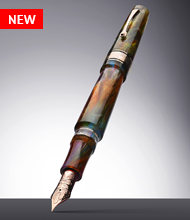
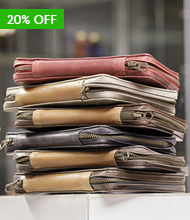
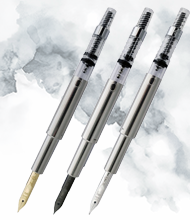
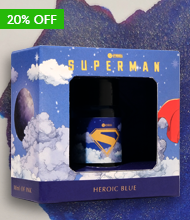
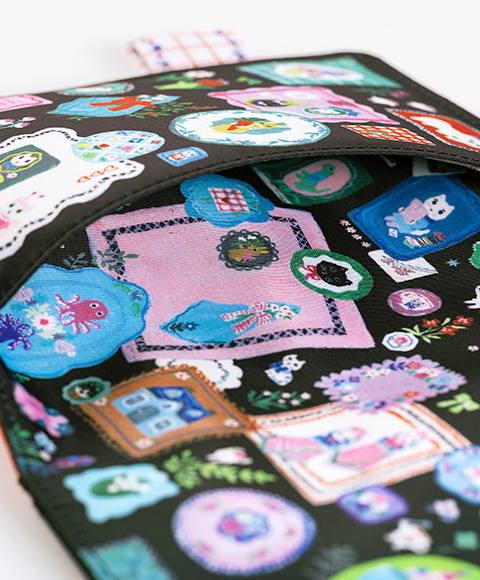
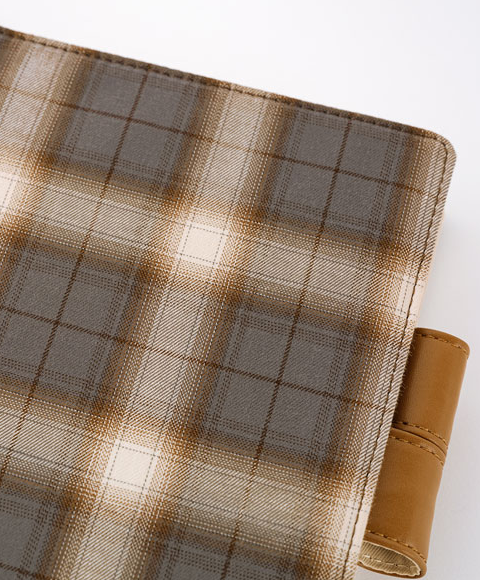

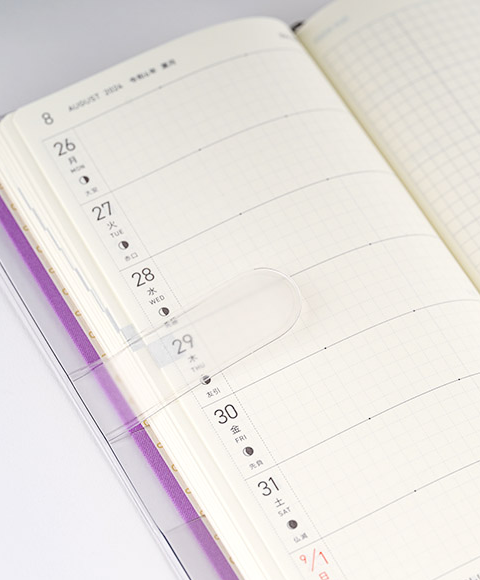
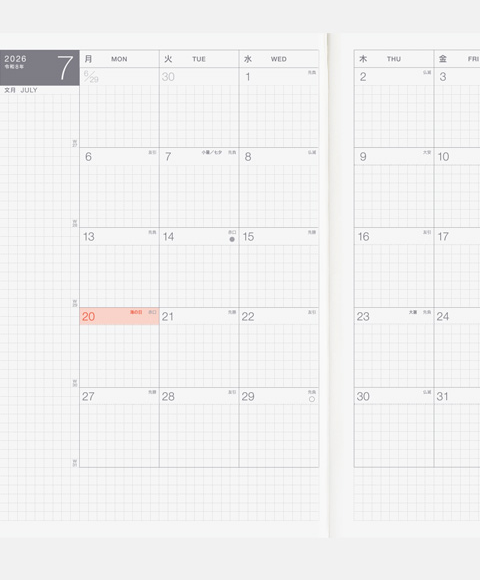
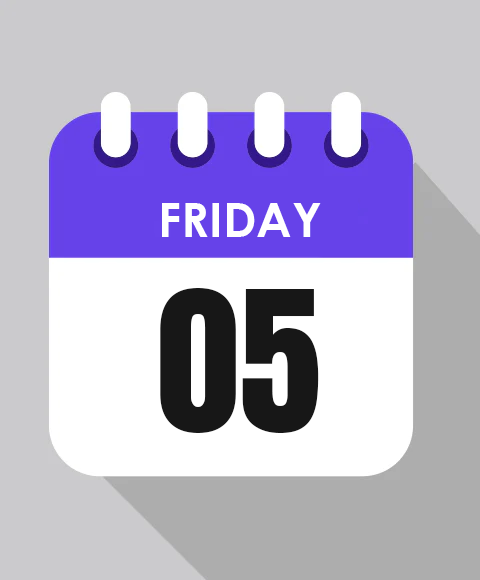
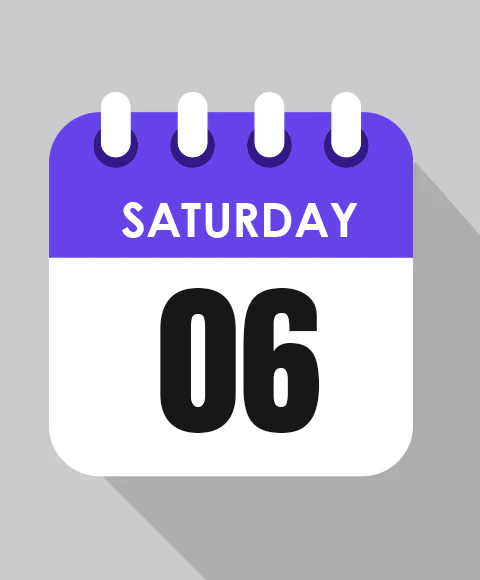
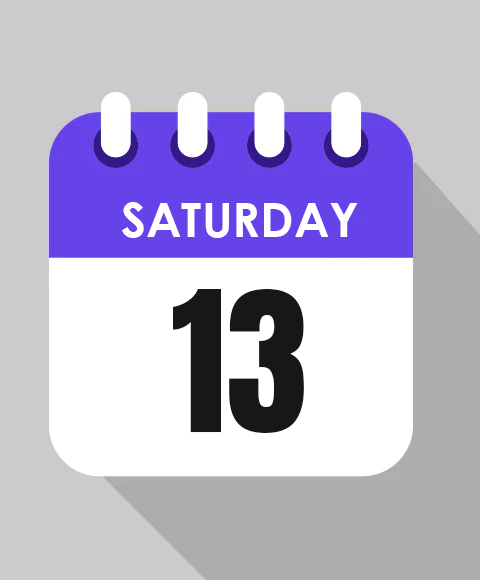
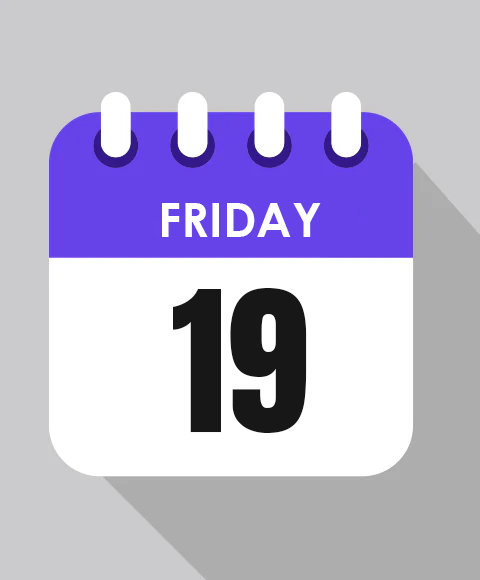
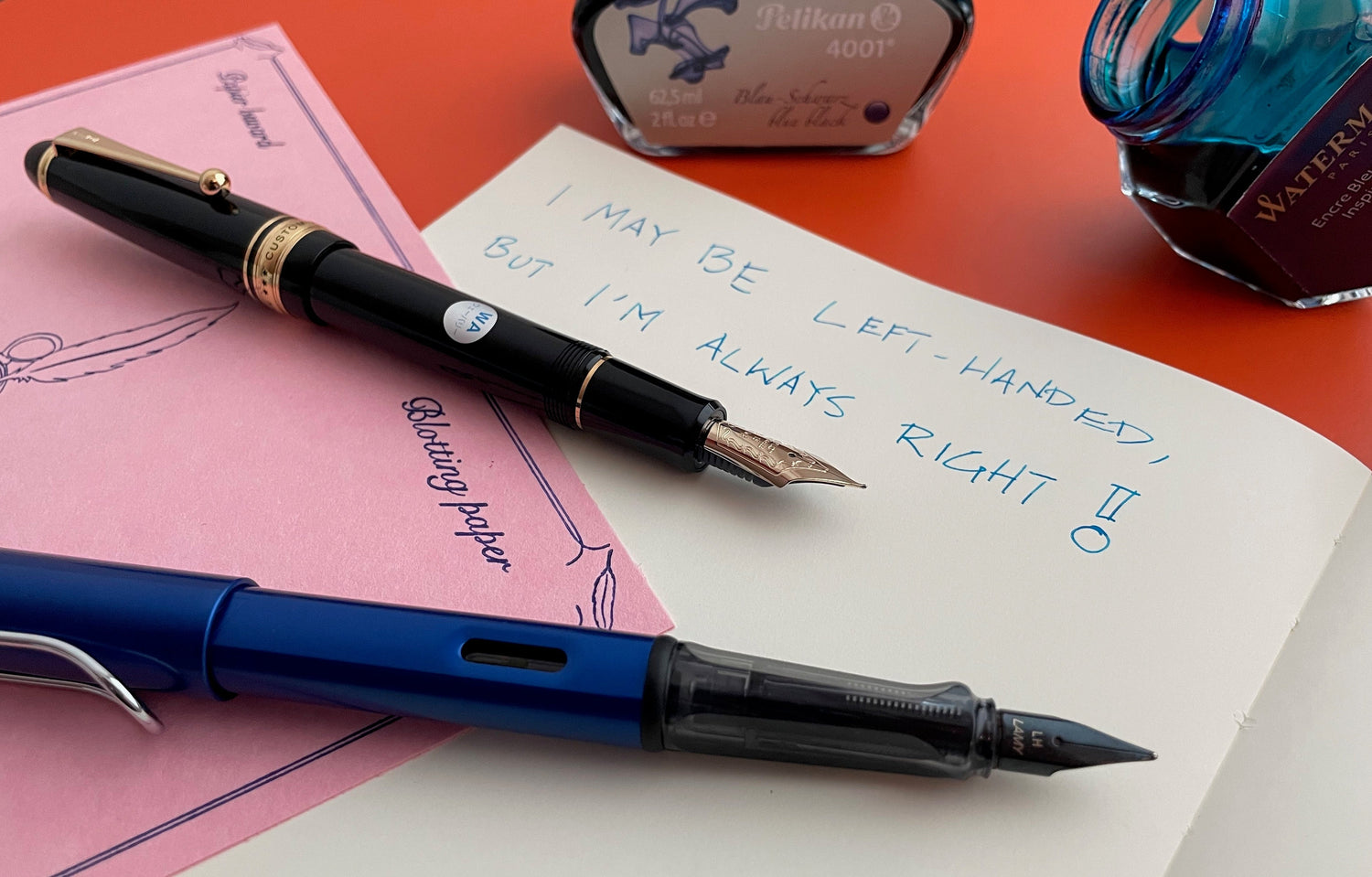
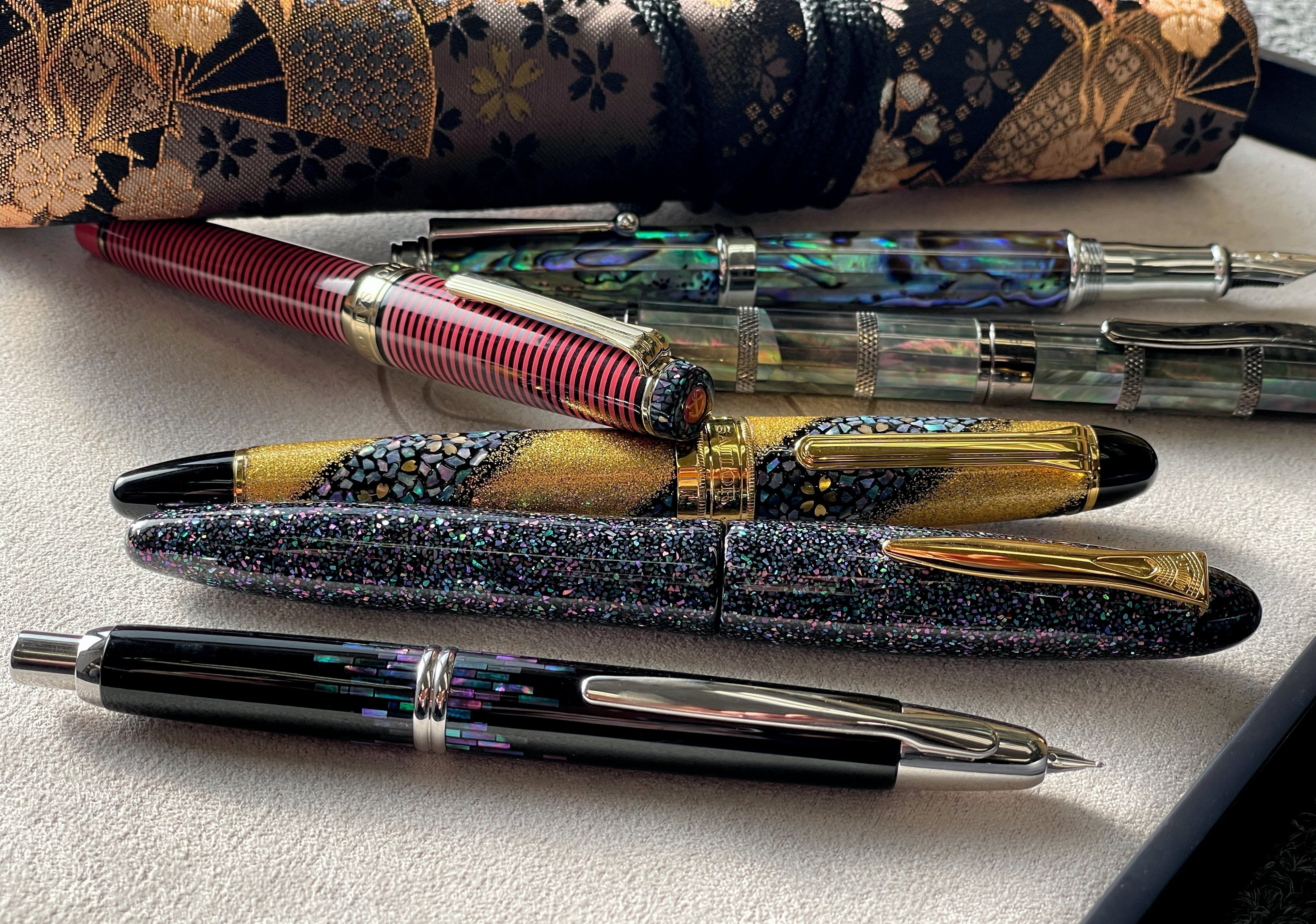
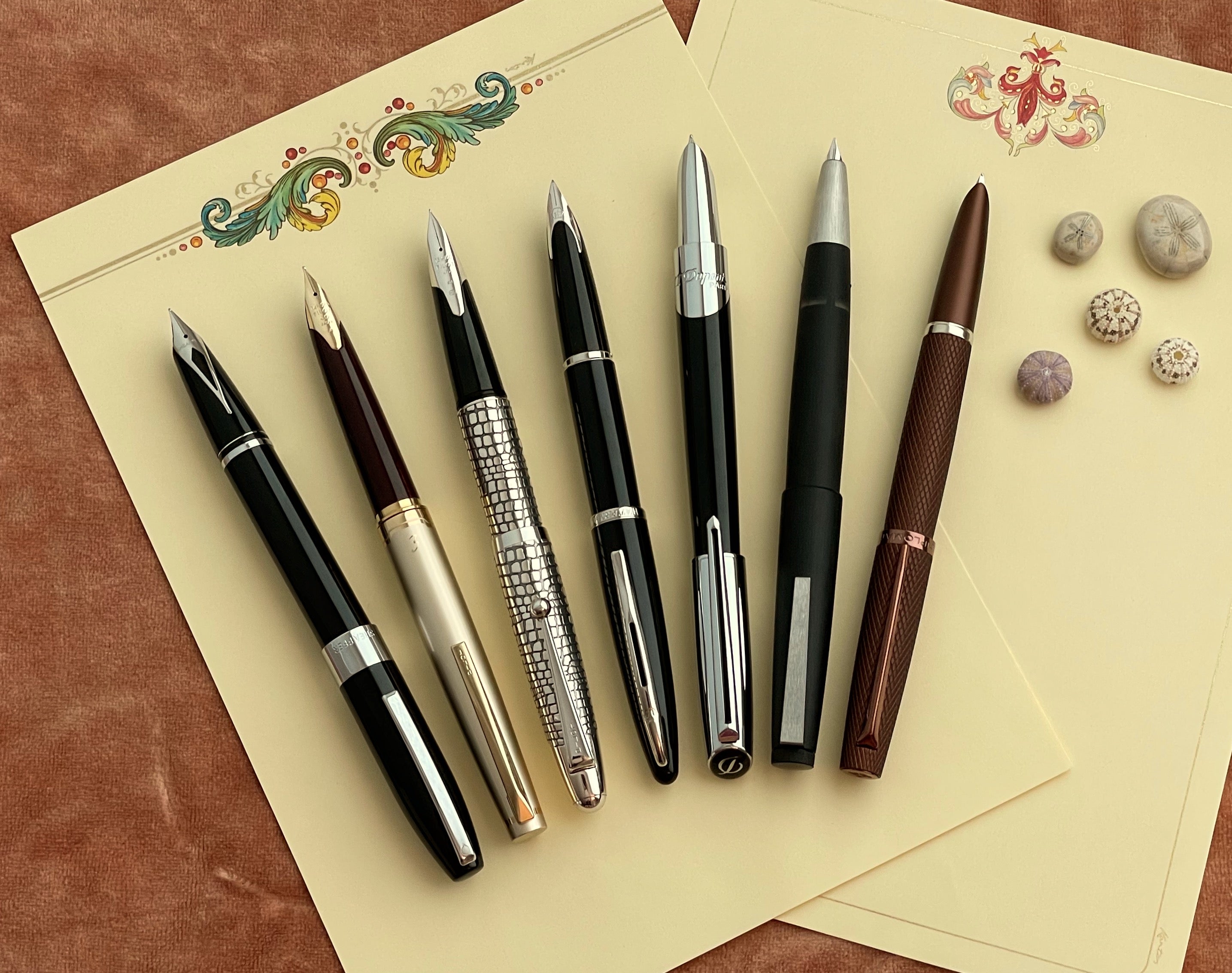

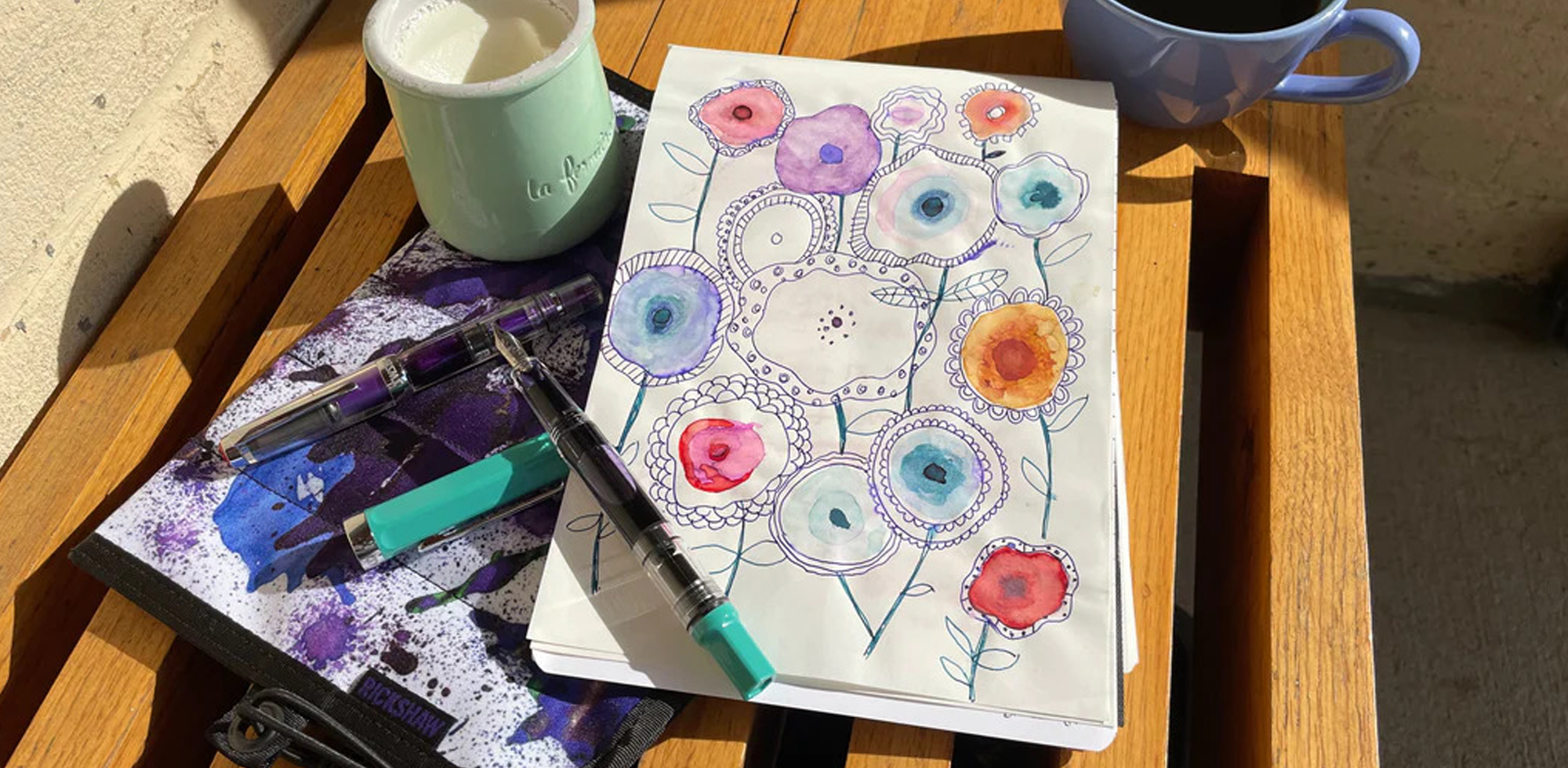
7 comments
Eric Arnold
An excellent article, as always, thanks Laura! While I am not a left hander, I found this article most useful, and very much appreciate your chasing this topic, and I look forward to another article about inks! I, too, keep a rocker blotter on jy desk at all times, and have gotten a great bit of use from it. I feel like blotter paper is often overlooked.
I have had the opportunity to see Pierce write with a number of pens in the store, and one doesn’t immediately notice that he is a lefty; his work with these pens is so comfortable and natural it seems no different than a righty when he picks one up. In fact, I’ve seen other customers have that lightbulb moment and say “Wait, you’re left-handed!” In case there are any lingering doubts amongst eft handed readers out there, I would note that my read is that one of Pierce’s favorite pens was not mentioned in this article. He recently picked up a vintage Pelikan at the DC pen show (after seriously trying to talk me out of one of mine!), and he is overjoyed with it! His writing with that pen looks just as good as with any off those mention in this article!
Laura, very much appreciate all of the cross references to you other articles, which make your reader’s deep diving quite a bit easier! Bravo, another great contribution to the fountain pen knowledge base!
An excellent article, as always, thanks Laura! While I am not a left hander, I found this article most useful, and very much appreciate your chasing this topic, and I look forward to another article about inks! I, too, keep a rocker blotter on jy desk at all times, and have gotten a great bit of use from it. I feel like blotter paper is often overlooked.
I have had the opportunity to see Pierce write with a number of pens in the store, and one doesn’t immediately notice that he is a lefty; his work with these pens is so comfortable and natural it seems no different than a righty when he picks one up. In fact, I’ve seen other customers have that lightbulb moment and say “Wait, you’re left-handed!” In case there are any lingering doubts amongst eft handed readers out there, I would note that my read is that one of Pierce’s favorite pens was not mentioned in this article. He recently picked up a vintage Pelikan at the DC pen show (after seriously trying to talk me out of one of mine!), and he is overjoyed with it! His writing with that pen looks just as good as with any off those mention in this article!
Laura, very much appreciate all of the cross references to you other articles, which make your reader’s deep diving quite a bit easier! Bravo, another great contribution to the fountain pen knowledge base!
Barry Gabay
Thank you, Laura, for this very interesting article. Very informative for everyone, including all of us left-handed writers. My Lamy Safari with LH (Left Hand) nib is a great writer.
Thank you, Laura, for this very interesting article. Very informative for everyone, including all of us left-handed writers. My Lamy Safari with LH (Left Hand) nib is a great writer.
Julia Cording
Thank you so much for your attention to lefties! As usual, your post was detailed and filled with helpful information. Yes, I’m a lefty, and my first “fancy” fountain pen purchase was a used Sailor 1911S. While I still love that pen (and its feedback), I didn’t know about the Lefty version of the 1911L! Thanks to your article, I’ve added two new pens to my wish list.
Thank you so much for your attention to lefties! As usual, your post was detailed and filled with helpful information. Yes, I’m a lefty, and my first “fancy” fountain pen purchase was a used Sailor 1911S. While I still love that pen (and its feedback), I didn’t know about the Lefty version of the 1911L! Thanks to your article, I’ve added two new pens to my wish list.
Amy C
Fun article! I’m a lefty overwriter fountain pen fanatic who avoided fountain pens for YEARS because of the prevailing advice that they wouldn’t work for me. Now the advice I give fellow lefties who are FP-curious is to 1) assume that they can use any pen, 2) keep a blotting paper or cloth nearby, and 3) learn to embrace inky fingers. And I absolutely agree about the Pilot nibs.
Fun article! I’m a lefty overwriter fountain pen fanatic who avoided fountain pens for YEARS because of the prevailing advice that they wouldn’t work for me. Now the advice I give fellow lefties who are FP-curious is to 1) assume that they can use any pen, 2) keep a blotting paper or cloth nearby, and 3) learn to embrace inky fingers. And I absolutely agree about the Pilot nibs.
Lynn Tedder
As a lefty myself, I enjoyed this article very much, especially the discussion of nib angles and ink feed. I wanted to share my own best tip for writing left-handed. It’s from an old book on Italic calligraphy, and that is to cant your paper to the right instead of the left. This places your hand in almost the same position as a right-handed writer, below the letters. You do have to adjust the angle of the nib, but I have found that I can write almost any hand except Copperplate with almost any pen.
As a lefty myself, I enjoyed this article very much, especially the discussion of nib angles and ink feed. I wanted to share my own best tip for writing left-handed. It’s from an old book on Italic calligraphy, and that is to cant your paper to the right instead of the left. This places your hand in almost the same position as a right-handed writer, below the letters. You do have to adjust the angle of the nib, but I have found that I can write almost any hand except Copperplate with almost any pen.
Mark S
Hi,
Great to see an article for us lefties…..
Although I cringe at seeing the photos of overwriters and sidewriters.
I think long-term this can create issues with your hand muscles. Probably good for the physical therapists thought.
At least for me, I have found that being an underwriter is easy on my hands and avoids smudging. I highly recommend this option over the others and have no need for any special pens or nibs using this technique.
Just my 2¢….
Mark
Hi,
Great to see an article for us lefties…..
Although I cringe at seeing the photos of overwriters and sidewriters.
I think long-term this can create issues with your hand muscles. Probably good for the physical therapists thought.
At least for me, I have found that being an underwriter is easy on my hands and avoids smudging. I highly recommend this option over the others and have no need for any special pens or nibs using this technique.
Just my 2¢….
Mark
Idalee DiGregorio
Great article. As a lefty i have always wanted more info about which pens are easier or harder.
Great article. As a lefty i have always wanted more info about which pens are easier or harder.